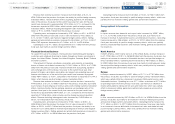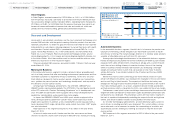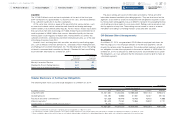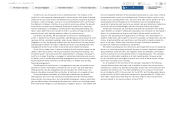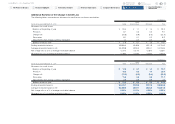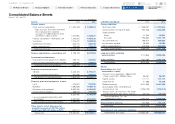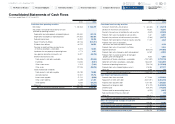Honda 2014 Annual Report Download - page 42
Download and view the complete annual report
Please find page 42 of the 2014 Honda annual report below. You can navigate through the pages in the report by either clicking on the pages listed below, or by using the keyword search tool below to find specific information within the annual report.
The following table provides information related to losses on operating leases
due to customer defaults:
Yen (billions)
Fiscal years ended March 31 2013 2014
Provision for credit losses on past
due rental payments ¥1.1 ¥1.7
Impairment losses on operating leases
due to early termination ¥4.7 ¥3.3
Fiscal Year 2014 Compared with Fiscal Year 2013
The provision for credit losses on finance receivables increased by ¥11.2 billion,
or 122.9%, and net charge-offs increased by ¥2.9 billion, or 21.6%. The increase
in net charge-offs was primarily due to the increase in finance receivables and
declines in used vehicle prices which reduced recoveries on repossessed col-
lateral in North America. Impairment losses on operating leases due to early
termination decreased by ¥1.4 billion, or 29.8%.
Losses on Lease Residual Values
Our finance subsidiaries in North America determine contractual residual values of
lease vehicles at lease inception based on expectations of future used vehicle
values, taking into consideration external industry data and our own historical
experience. Lease customers have the option at the end of the lease term to
return the vehicle to the dealer or to buy the vehicle for the contractual residual
value (or if purchased prior to lease maturity, at the outstanding contractual
balance). Returned lease vehicles can be purchased by the grounding dealer for
the contractual residual value (or if purchased prior to lease maturity, at the
outstanding contractual balance) or through market based pricing programs.
Returned lease vehicles that are not purchased by the grounding dealers are sold
through online and physical auctions. We are exposed to risk of loss on the dispo-
sition of returned lease vehicles when the proceeds from the sale of the vehicles
are less than the contractual residual values at the end of the lease term.
We assess our estimates for end of term market values of lease vehicles, at
minimum, on a quarterly basis. The primary factors affecting the estimates the
percentage of leased vehicles that we expect to be returned by the lessee at the
end of lease term and the expected loss severity. Factors considered in this evalu-
ation include, among other factors, economic conditions, historical trends, and
market information on new and used vehicles. For operating leases, adjustments
to estimated residual values are made on a straight-line basis over the remaining
term of the lease and are included as depreciation expense. For direct financing
leases, downward adjustments for declines in estimated residual values deemed
to be other-than-temporary are recognized as a loss on lease residual values in
the period in which the estimate changed.
We also review our investment in operating leases for impairment whenever
events or changes in circumstances indicate that their carrying values may not be
recoverable. If impairment conditions are met, impairment losses are measured by
the amount carrying values exceed their fair values. There were no events or cir-
cumstances that indicated that the carrying values of our operating leases would
not be recoverable during the fiscal years ended March 31, 2012, 2013, and 2014.
We believe that our estimated losses on lease residual values and impairment
losses is a “critical accounting estimate” because it is highly susceptible to market
volatility and requires us to make assumptions about future economic trends and
lease residual values, which are inherently uncertain. We believe that the assump-
tions used are appropriate. However actual losses incurred may differ from original
estimates as a result of actual results varying from those assumed in our estimates.
If future auction values for all Honda and Acura vehicles in our North American
operating lease portfolio as of March 31, 2014, were to decrease by approximately
¥10,000 per unit from our present estimates, holding all other assumption con-
stant, the total impact would be an increase in depreciation expense by approxi-
mately ¥4.6 billion, which would be recognized over the remaining lease terms.
Similarly, if future return rates for our existing portfolio of all Honda and Acura
vehicles were to increase by one percentage point from our present estimates, the
total impact would be an increase in depreciation expense by approximately ¥0.6
billion, which would be recognized over the remaining lease terms. With the same
prerequisites shown above, if future auction values in our North American direct
financing lease portfolio were to decrease by approximately ¥10,000 per unit from
our present estimates, the total impact would be an increase in losses on lease
residual values by approximately ¥0.1 billion. And if future return rates were to
increase by one percentage point from our present estimates, the total impact
would be slight. Note that this sensitivity analysis may be asymmetric, and are
specific to the base conditions in fiscal 2014. Also, declines in auction values are
likely to have a negative effect on return rates which could affect the sensitivities.
Pension and Other Postretirement Benefits
We have various pension plans covering substantially all of our employees in
Japan and certain employees in foreign countries. Benefit obligations and pension
costs are based on assumptions of many factors, including the discount rate, the
rate of salary increase and the expected long-term rate of return on plan assets.
The discount rate is determined mainly based on the rates of high quality corpo-
rate bonds currently available and expected to be available during the period to
maturity of the defined benefit pension plans. The salary increase assumptions
reflect our actual experience as well as near-term outlook. Honda determines the
expected long-term rate of return based on the investment policies. Honda con-
siders the eligible investment assets under investment policies, historical experi-
ence, expected long-term rate of return under the investing environment, and the
long-term target allocations of the various asset categories. Our assumed dis-
count rate and rate of salary increase as of March 31, 2014 were 1.5% and 2.2%,
Honda Motor Co., Ltd. Annual Report 2014 41
6 Financial Section
1 The Power of Dreams
2 Financial Highlights
3 To Our Shareholders
4 Review of Operations
5 Corporate Governance
7
Investor Relations
Information
Return to last
page opened
Go to
contents page




